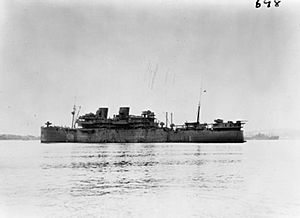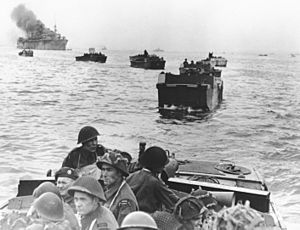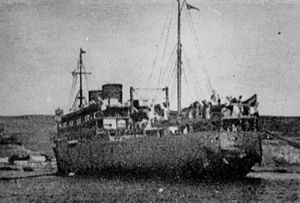MV Llangibby Castle facts for kids

In naval service during World War II
|
|
Quick facts for kids History |
|
|---|---|
| Name | MV Llangibby Castle |
| Owner | |
| Port of registry | |
| Builder | Harland and Wolff, Govan, Glasgow |
| Yard number | 841 |
| Launched | 4 July 1929 |
| Completed | 21 November 1929 |
| Fate | Sold for scrapping on 29 June 1954 |
| General characteristics | |
| Type | Passenger liner |
| Tonnage | 11,951 gross register tons (GRT) |
| Length | 485 ft 7 in (148.01 m) |
| Beam | 66 ft 2 in (20.17 m) |
| Depth | 29 ft 5 in (8.97 m) |
| Propulsion |
|
| Speed | 14.5 knots (26.9 km/h) |
The MV Llangibby Castle was a large passenger liner ship. It was part of the Union-Castle Line fleet. The ship sailed from 1929 to 1954. It was named after Llangybi Castle in Monmouthshire, Wales.
The Llangibby Castle was built by Harland and Wolff in Govan, Glasgow, Scotland. It was special because it used a new engine technology for its time. The ship mostly sailed on a route around Africa.
In 1940, at the start of World War II, the ship carried Germans from Kenya and Tanzania to Genoa, Italy. This happened before Italy officially joined the war against Britain and France. Later that year, in December 1940, the ship was damaged during an air raid in Liverpool.
Contents
A Ship of War: Troopship Service
The Llangibby Castle became a troopship during World War II. This meant it carried soldiers and military equipment. On January 16, 1942, a German submarine called U-402 attacked the ship. The torpedo hit the back of the ship, killing 26 people. It also destroyed the ship's back gun and its rudder, which is used for steering.
Even with the damage, the ship's engines still worked. It was able to slowly make its way to Horta in the Azores islands. The crew steered the ship using only its engines. During this journey, German planes tried to attack the ship, but it fought them off. The Llangibby Castle arrived safely in Horta on January 19.
Repairs and Return to Service
The ship could only stay in Horta for 14 days because Portugal was a neutral country. After some quick repairs, it sailed again on February 2, heading for Gibraltar. It was protected by three destroyers and towed by a tugboat called Thames. German submarines followed the convoy, but the ships escaped further damage. One of the escort ships, HMS Westcott, even sank a German submarine, U-581.
The small convoy reached Gibraltar on February 8. The soldiers on board got off the ship, and more temporary repairs were done. The Llangibby Castle then sailed for Britain on April 6, still without a proper rudder. It arrived in Britain on April 13. The ship had traveled 3,400 miles with a damaged back and steering only with its engines. This was an amazing achievement! The ship's captain, Mr. Bayer, was given a special award called the OBE for his bravery.
After full repairs, the Llangibby Castle went back to being a troopship. It took part in Operation Torch on November 9, 1942. During this operation, a shell from a shore battery hit the ship, and one man was killed.
Transporting Tanks
On November 25, the ship loaded many tanks, trucks, and supplies in Scotland. These belonged to a group of soldiers called the 2nd Lothians and Border Horse. They loaded 52 tanks, 11 light tanks, and many other vehicles and supplies. On November 28, the ship sailed, not knowing its exact destination.
As the ship entered the Mediterranean Sea, it was involved in a serious collision on December 4. Everyone on board prepared to get into the lifeboats. Luckily, the ship was not sinking, but its front was badly damaged. It could not continue its journey. Instead, it went to the nearest friendly port, Gibraltar.
The soldiers quickly unloaded their heavy equipment in Gibraltar. They then loaded all their tanks and gear onto another ship, the Llanstephan Castle. This was done very quickly so they could rejoin the Allied invasion fleet. After this, the Llangibby Castle went back to the UK for more repairs. It was then changed into a Landing Ship, Infantry. This type of ship is designed to carry and land soldiers directly onto beaches.

After training, the ship transported troops in the Mediterranean. In 1944, it was part of the Normandy landings, a huge invasion of France. It carried over 1,500 Canadian soldiers to Juno Beach. The ship landed the troops in two groups. Later, it helped land troops at Omaha Beach and Utah Beach, and at Le Havre. For the last year of the war, it served as a troopship in the Far East.
Post-War Life
After the war, the Llangibby Castle returned to its normal passenger service. In 1948, the editor of The Times newspaper, Robert McGowan Barrington-Ward, died while he was a passenger on the ship in Dar es Salaam. In December 1949, also in Dar es Salaam, a serious fire broke out in the ship's cargo hold.
Ship's Final Journey
The Llangibby Castle was sold for scrap on June 29, 1954. It was taken apart at the John Cashmore yard in Newport Docks on July 12, 1954.
Images for kids



